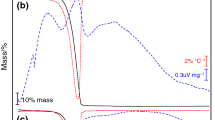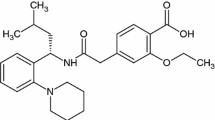Abstract
The nonisothermal degradation process of Folnak® drug samples was investigated by simultaneous thermogravimetric and differential thermal analysis in the temperature range from an ambient one up to 810°C. It was established that the degradation proceeds through the five degradation stages (designated as I, II, III, IV, and V), which include: the dehydration (I), the melting process of excipients (II), as well as the decomposition of folic acid (III), corn starch (IV), and saccharose (V), respectively. It was established that the presented excipients show a different behavior from that of the pure materials. During degradation, all excipients increase their thermal stability, and some kind of solid–solid and/or solid–gas interaction occurs. The kinetic parameters and reaction mechanism for the folic acid decomposition were established using different calculation procedures. It was concluded that the folic acid decomposition mechanism cannot be explained by the simple reaction order (ROn) model (n = 1) but with the complex reaction mechanism which includes the higher reaction orders (RO, n > 1), with average value of <n > = 1.91. The isothermal predictions of the third (III) degradation stage of Folnak® sample, at four different temperatures (T iso = 180°C, 200°C, 220°C, and 260°C), were established. It was concluded that the shapes of the isothermal conversion curves at lower temperatures (180–200°C) were similar, whereas became more complex with further temperature increase due to the pterin and p-amino benzoic acid decomposition behavior, which brings the additional complexity in the overall folic acid decomposition process.









Similar content being viewed by others
References
Hoffbrand AV, Weir DG. The History of folic acid. Br J Haematol. 2001;113:579–89.
Ebisch IMW, Thomas CMG, Peters WHM, Braat DDM, Steegers-Theunissen RPM. The importance of folate, zinc and antioxidants in the pathogenesis and prevention of subfertility. Hum Reprod Updat. 2007;13:163–74.
Samuel CE, Rabinowitz JC. Initiation of protein synthesis by folate-sufficient and folate-deficient streptococcus faecalis R. J Biol Chem. 1974;249:1198–206.
Helms RA, Herfindal ET, Quan DJ, Gourley DR. Textbook of therapeutics: drug and disease management. 8th ed. Philadelphia: Lippincott Williams & Wilkins, Wolters Kluwer Health; 2006. p. 75–95.
Gomber S, Kela K, Dhingra N. Clinico-hematological profile of megaloblastic anemia. Ind Pediatr. 1998;35:55–8.
Gomber S, Dewan P, Dua T. Homocystinuria: a rare cause of megaloblastic anemia. Ind Pediatr. 2004;41:941–3.
Ford JL, Timmins P. Pharmaceutical thermal analysis, techniques and applications. Chichester: Ellis Horwood; 1989. p. 20–30.
Tņnesen HH, Moore DE. Photochemical stability of biologically active compounds. III. Mefloquine as a photosensitizer. Int J Pharm. 1991;70:95–101.
Brown ME, Dollimore D, Galwey AK. Reactions in the solid state. In: Bamford CH, Tipper CFH, editors. Comprehensive chemical kinetics, vol. 22. Amsterdam: Elsevier; 1980. p. 22–3.
Senum GI, Yang RT. Rational approximations of the integral of the Arrhenius equation. J Therm Anal Calorim. 1977;11:445–7.
Vyazovkin S, Wight CA. Model-free and model-fitting approaches to kinetic analysis of isothermal and nonisothermal data. Thermochim Acta. 1999;340–341:53–68.
Khawam A, Flanagan DR. Basics and applications of solid-state kinetics: a pharmaceutical perspective. J Pharm Sci. 2006;95:472–98.
Kissinger HE. Reaction kinetics in differential thermal analysis. Anal Chem. 1957;29:1702–6.
Akahira T, Sunose T. Joint convention of four electrical institutes. Research report (Chiba Institute of Technology). Sci Technol. 1971;16:22–31.
Coats AW, Redfern JP. Kinetic parameters from thermogravimetric data. Nature. 1964;201:68–9.
Doyle CD. Estimating isothermal life from thermogravimetric data. J Appl Polym Sci. 1962;6:639–42.
Ozawa T. A new method of analyzing thermogravimetric data. Bull Chem Soc Jpn. 1965;38:1881–6.
Málek J. The kinetic analysis of non-isothermal data. Thermochim Acta. 1992;200:257–69.
Málek J. A computer program for kinetic analysis of non-isothermal thermoanalytical data. Thermochim Acta. 1989;138:337–46.
Liu X, Yu L, Liu H, Chen L, Li L. In situ thermal decomposition of starch with constant moisture in a sealed system. Polym Degrad Stab. 2008;93:260–2.
Beninca C, Demiate IM, Lacerda LG, Carvalho Filho MAS, Ionashiro M, Schnitzler E. Thermal behavior of corn starch granules modified by acid treatment at 30 and 50°C. Ecl Quím, São Paulo. 2008;33:13–8.
Suñol JJ, Farjas J, Berlanga R, Saurina J. Thermal analysis of a polyethylene glycol (PEG 4000): T-CR-T diagram construction. J Therm Anal Calorim. 2000;61:711–8.
Araújo AS, Storpirtis S, Mercuri LP, Carvalho FMS, Santos Filho M, Matos JR. Thermal analysis of the antiretroviral zidovuine (AZT) and evaluation of the compatibility with excipients used in solid dosage forms. Int J Pharm. 2003;260:303–14.
Mura P, Faucci MT, Manderioli A, Bramanti G, Ceccarelli L. Compatibility study between ibuproxam and pharmaceutical excipients using differential scanning calorimetry, hot-stage microscopy and scanning electron microscopy. J Pharm Biomed Anal. 1998;18:151–63.
Jaw K-S, Hsu C-K, Lee J-S. The thermal decomposition behaviors of stearic acid, paraffin wax and polyvinyl butyral. Thermochim Acta. 2001;367–368:165–8.
Bartsch SE, Griesser UJ. Physicochemical properties of the binary system glibenclamide and polyethylene glycol 4000. J Therm Anal Calorim. 2004;77:555–69.
Vora A, Riga A, Dollimore D, Alexander KS. Thermal stability of folic acid. Thermochim Acta. 2002;392–393:209–20.
Orozco VH, Brostow W, Chonkaew W, López BL. Preparation and characterization of poly(lactic acid)-g-maleic anhydride + starch blends. Macromol Symp. 2009;277:69–80.
Zhang X, Golding J, Burgar I. Proceedings of the 7th world conference on biodegradable polymers & plastics. Pisa, Italy, June 4–8, 2002. pp 131–132.
Aggarwal P, Dollimore D, Heon K. Comparative thermal analysis study of two biopolymers, starch and cellulose. J Therm Anal Calorim. 1997;50:7–17.
Fares MM, El-Faqeeh AS. Thermal and thermoxidative degradations of starch and thermosensitive starch-g-BAM copolymers. J Therm Anal Calorim. 2005;82:161–6.
Aggarwal P, Dollimore D. The effect of chemical modification on starch studied using thermal analysis. Thermochim Acta. 1998;324:1–8.
Lerdkanchanaporn S. A thermal analysis study of ibuprofen and starch mixtures using simultaneous TG-DTA. Thermochim Acta. 1999;340–341:131–8.
Kim DS, Soderquist CZ, Icenhower JP, McGrail BP, Scheele RD, McNamara BK, et al. Tc reductant Chemistry and crucible melting studies with simulated Hanford low-activity waste. Prepared for the U.S. Department of Energy under Contract DE-AC 05-76RL01830, Pacific Northwest National Laboratory operated by Battelle for the United States Department of Energy, Oak Ridge, TN 37831-0062, 2005. pp 44–47.
Rodante F, Vecchio S, Materazzi S, Vasca E. Kinetic and thermodynamic study of the Na4(UO2)2 (OH)4(C2O4)2 complex. Int J Chem Kinet. 2003;35:661–9.
Montserrat S, Málek J, Colomer P. Thermal degradation kinetics of epoxy-anhydride resins: I. Influence of a silica filler. Thermochim Acta. 1998;313:83–95.
Anderson HL, Kemmler A, Strey R. Comparison of different non-linear evaluation methods in thermal analysis. Thermochim Acta. 1996;271:23–9.
Opfermann J. Kinetic analysis using multivariate non-linear regression. I. Basic concepts. J Therm Anal Calorim. 2000;60:641–58.
Smyth GK. Nonlinear regression. In: El-Shaarawi AH, Piegorsch WW, editors. Encyclopedia of environmetrics, vol. 3. Chichester: Wiley; 2002. p. 1405–11.
Acknowledgment
This study was partially supported by the Ministry of Science and Development of Serbia under Project 142025.
Author information
Authors and Affiliations
Corresponding author
Rights and permissions
About this article
Cite this article
Jankovi, B. Thermal Stability Investigation and the Kinetic Study of Folnak® Degradation Process Under Nonisothermal Conditions. AAPS PharmSciTech 11, 103–112 (2010). https://doi.org/10.1208/s12249-009-9363-6
Received:
Accepted:
Published:
Issue Date:
DOI: https://doi.org/10.1208/s12249-009-9363-6




